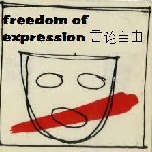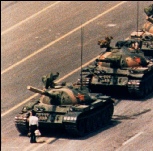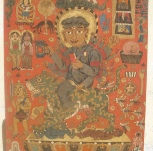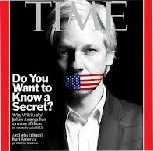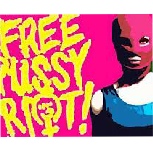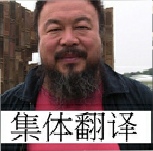


Fairey Tale
by David Lipke for WWD. Feb 12 2009
Shepard Fairey, the artist behind the iconic Obama "Hope" portrait, has a big few months ahead of him: opening a show at Boston's ICA, a collaboration with Saks Fifth Avenue, and legal troubles with the Associated Press.
Fame can come with a price, as Shepard Fairey is learning.
In what should be a triumphant moment in the street artist's career—his first museum retrospective opened last week at Boston's Institute of Contemporary Art—Fairey instead finds himself in a maelstrom of controversy. He was arrested on Friday on graffiti-related charges while trying to enter the museum, and he's also become embroiled in a legal battle with the Associated Press, which has charged him with misappropriating a copyrighted photo as the basis for his now-iconic Obama "Hope" portrait from last year's election. Fairey has filed a preemptive lawsuit in response to the AP's public charges, in an effort to have a federal judge rule his use of the photograph is legal.
"They targeted me because I'm a symbol. I think my arrest was a reflection of an old way of thinking and amplifies the abuses of power that are discussed in my work," Fairey told WWD following his arrest. "They're trying to make a statement about the culture that I'm promoting."
Fairey, 38, is no stranger to legal flak. He's been arrested 15 times now by his count—at least one of which resulted in a nasty beating—and jail time is an occupational hazard when your canvas consists of public property. Fairey has pleaded not guilty to the most recent misdemeanor vandalism charges in Boston, but he faces a potential prison sentence, fine and loss of his driver's license.
"I think every taxpayer owns a piece of public property," said Fairey of his justification for using public spaces for his art. "Street art is a way to connect with an audience directly, without any bureaucracy. Being arrested is a risk I take, and I think it's worth it."
Despite the legal implications, the ICA has clearly given Fairey and street art an imprimatur of cultural relevance and establishment recognition. "Think back to the '80s and Keith Haring and the East Village school—there's a freshness and inventiveness and wit to street art. It's a very democratic form and that feels very resonant today," said Nicholas Baume, chief curator of the ICA. "When people see this exhibition I think they are going to be bowled over. Fairey's mastery of technique, form, color, texture and layering is incredible."
As for Fairey's lawsuit against the AP, which is asking a federal judge to declare his Obama portrait does not infringe on the news organization's copyright claims, Anthony Falzone, the artist's lead attorney, said there was no doubt about the legality of the Obama portrait. "He used [the AP's] photograph for a purpose entirely different from the original, and transformed it dramatically," explained Falzone, who is executive director of the Fair Use Project at Stanford University's Center for Internet and Society. "The original photograph is a literal depiction of Obama, whereas Fairey's poster creates powerful new meaning and conveys a radically different message that has no analogue in the original photograph."
To view a slideshow of Shepard Fairey's work, click here (WWD subscription required).
Visitors to the ICA show, which runs through August 16, will see the Obama poster, of course, but will also get a look at a diverse body of work that ranges from massive, floor-to-ceiling murals to Post-It–size stickers. The exhibit is sponsored by Levi's, which has a long-standing relationship with Fairey, hosting one of his first shows in 2002 in the brand's San Francisco flagship. The company plans to unveil a special Fairey-designed garment on May 1, to be sold at the ICA store.
Much of Fairey's work is based on the bold, graphic aesthetic of Bolshevik and Chinese propaganda posters of the '20s and '30s, and themes of power, conformity, and modern consumer society permeate his oeuvre. Like artist Barbara Kruger, Fairey often incorporates text tinged with political irony into his images.
"What I'm interested in showing is the complexities of life, and the paradox in a lot of situations," said Fairey. "Depending on which cultural perspective you are coming from, good and evil can be interchangeable."
Ambiguity has been a calling card in Fairey's work from the beginning. Prior to his Obama coup, he was best known for his absurdist campaign to ubiquitously sticker and stencil an image of the late professional wrestler Andre "The Giant" Roussimoff around cityscapes. Begun in 1989, while Fairey was still a student at the Rhode Island School of Design, the project took on a life of its own as the skater community began disseminating the image around the U.S.
But the meme was meaningless, according to Fairey. "The whole thing really started as an inside joke," he explained. "I thought it was an interesting experiment in phenomenology—that you could create something out of nothing."
Apart from his street art, and now his fine art (which is sold via New York's Jonathan LeVine gallery), Fairey is a partner in the streetwear label Obey Clothing, which is distributed in about 200 accounts and an e-commerce site. "I consider T-shirts one of my primary mediums, and clothing is a very important part of how I put my art out there," said Fairey.
Since 2001, Fairey has also operated an L.A.-based graphic design and marketing firm, called Studio Number One, which has done work for clients including Honda, Toyota, Dewars, Virgin Megastore, and, this March, the new Saks Fifth Avenue "Want it!" spring marketing campaign.
Fairey is fiercely loyal to his streetwear roots and he was initially gun-shy about shilling for an exclusive retailer like Saks. However, Terron Shaefer, group senior vice president of creative and marketing at Saks Fifth Avenue, persuaded him to come aboard after pointing out that artists like Takashi Murakami and Richard Prince weren't losing credibility by collaborating with Louis Vuitton.
"Listen, I don't think I have to apologize for working with Saks. I still sell my prints for $45 online. This was a high-caliber creative project and an exciting opportunity for my studio," said Fairey.
As for Saks, the choice of Fairey was easy. "This is about being noticed," said Schaefer. "If it got Obama elected, how bad can it be?"

